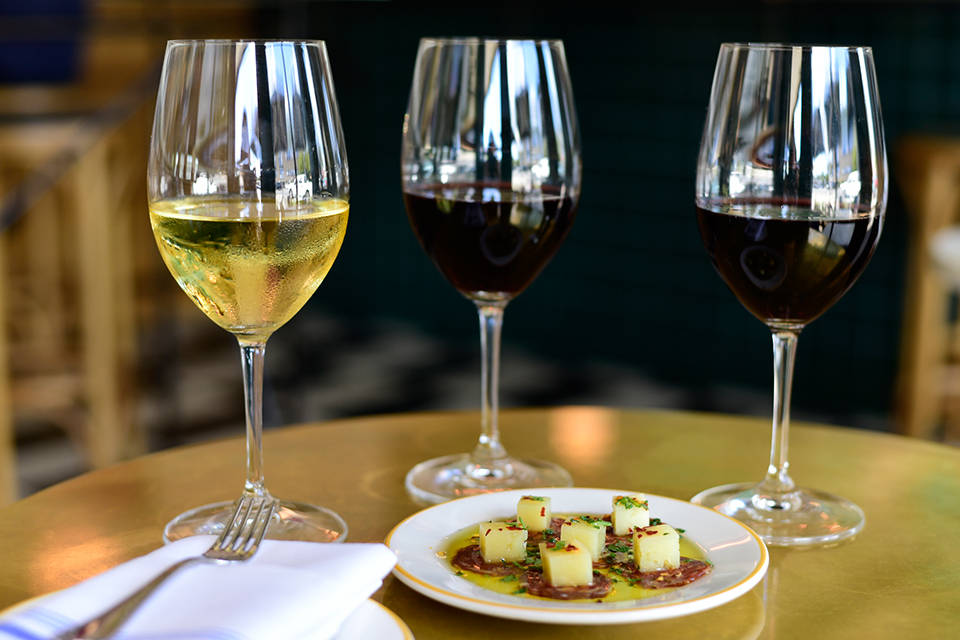Raise Your Glass

’Tis the season to celebrate, and nothing says celebration more than a “cheers” with the ones you hold dearest. But as the glasses add up, so do the calories. Do you know what you’re drinking?
Raise a Glass
WINE
Serving size: 6 oz.
Alcohol content: anywhere from 9 to 17 percent, depending on the type
Calories: 100-200 depending on the type
The amount of alcohol in a wine is directly related to its calorie count. For the most part, white wines tend to be lower in both calories and alcohol content than reds. Light whites will have around 140 calories per glass, while a high alcohol content red like a pinot noir can have more than 200.
Pro tip: There is a basic formula to calculate the calories in your wine:
% of alcohol x ounces x 1.6= calorie count
Always be sure to check with your server if the size of your pour is not clearly listed on the wine list.
Color is key. The color of wine is often a good indicator of its caloric and alcohol content. This Chardonnay on the left is the lightest, both in color and content, while the Cabernet Sauvignon Merlot Blend on the far right is the heaviest. Keep this in mind when you’re pouring that next glass.

Rewrite your cocktail rules—don’t be afraid to sneak your daily dose of vegetables into your drink. Vinaigrette is no stranger to this new mantra. Their Kale Mary puts a green twist on a classic, while their Raspbeeta incorporates raspberries, beets and tequila into a vibrant margarita your taste buds won’t forget… hard to beet that!
Poppin’ Bottles
CHAMPAGNE
Serving size: 4 oz.
Alcohol content: about 12 percent
Calories: approximately 90
Champagne has added sugar and alcohol; known as “le dosage,” it’s added during the production process. This added sugar is important to keep in mind when you’re having more than one glass. Luckily, serving sizes of champagne are typically smaller than other alcoholic beverages, keeping the calorie and sugar count lower.
Pro tip: Look for labels with “brut zero” or “brut nature,” which both mean hardly any extra sugar was added.
Crack Open a Cold One
BEER
Serving size: 12 oz.
Alcohol content: 3 to 10 percent; depending on the beer, most fall between 4 and 6 percent
Calories: 150 calories on average
Because beer doesn’t appear to be as strong as shots or cocktails, people tend to drink more in one sitting—causing a serious caloric overload. This can lead to the ever-dreaded beer belly.
Pro tip: Choose a light beer, which can have as little as 60 calories.
Beer’s Gluten-Free Brother
HARD CIDER
Serving size: 12 oz.
Alcohol content: 1.2 to 8.5 percent
Calories: 150 to mid 200 calories on average
Popular brand Angry Orchard has 210 calories per serving for their Green Apple variety
It’s bottled like beer, but offers an alternative for gluten-free drinkers that still want to be a part of the party. Yet, unlike sugar-free beer, cider has a high sugar content, due to the apples in its composition. This means higher caloric and carbohydrate counts in cider.
Pro tip: Look for brands that are lower in sugar such as Harpoon Craft Cider or Samuel Smith’s Organic Cider.
.jpg)
Whisler’s Colibrí Recipe:
1.5 oz El Silencio Espadin Mezcal
1 oz Fresh squeezed orange juice
.75 oz Golden beet syrup (1:1)
.25 oz Fresh squeezed lemon juice
1 barspoon Helbing Kümmel
Glass: Cocktail
Garnish: None
Inspiration: One day after grabbing a bottle of Juiceland’s Golden Glow fresh juice from Cuvée Coffee before a shift, I was incredibly impressed how delicious it was. It then got me thinking how much better it’d be if it were turned into a cocktail. That’s what sparked my little experiment to come up with a well-balanced cocktail with a similar taste profile. The end result being the Colibrí!
Down the Hatch
SHOTS
Serving size: 1.5 oz.
Alcohol content: typically 40 percent (80 proof)
Average Calories
Vodka: 97
Rum: 97
Whiskey: 105
Gin: 110
Tequila: 69
With no vitamins or minerals, hard liquor has no real nutritional value to be gained. Yet, served on their own, shots are the lowest caloric option when drinking alcohol. Just be sure you don’t overdo it, because shots are sure to leave you regretting them the next morning.
Pro tip: To avoid extra calories, drink your hard liquor with mixers such as seltzer or water and ice, with a spritz of lemon or lime. Avoid sugary sodas and juices.
Wasted Away Again
FROZEN MARGARITA
Serving size: 6 oz.
Alcohol content: 40 percent
Calories: 300
The mixers necessary to create the perfect marg are filled with unnecessary sugars and calories that can quickly add up. Further, margarita mixers are often laden with sodium, even if you skip the salted rim. It’s best to avoid margaritas, especially in restaurants where they typically aren’t using fresh ingredients. If you simply can’t resist… limit yourself to just one.
Pro tip: Frozen margaritas tend to have more calories because of their high content of fruit juice. Go for a marg on the rocks when you need your Mexican beverage fix.
Why does alcohol make us gain weight?
When you drink, your body receives the alcohol as toxins and puts all effort into processing it—stopping the processing of the nutrients and what you ate for lunch, in the meantime. Your normal digestion is put on the back burner, meaning it’s likelier for your body to store excess fat. At the same time, drinking can leave us feeling hungrier. Studies support that drinking alcohol suppresses leptin, the hormone that functions for appetite suppression. Without our body telling us we’re full, we tend to eat and eat and eat, unaware just how much we overate. Further, drinking lowers inhibitions, making that slice of pizza look more enticing than ever.






